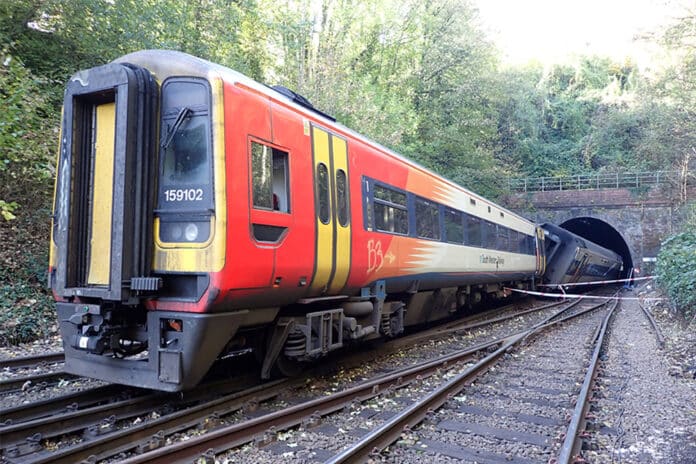The Rail Accident Investigation Branch (RAIB) and South Western Railway have provided statements on a crash in Salisbury which left a driver in hospital – with what British Transport Police has said are injuries “believed to be life-changing”.
The RAIB says it understands the driver of the SWR train, despite applying the brakes and using the emergency braking system, was unable to stop at a red signal.
As a result the two trains collided, and the driver is in hopsital with what are thought to be serious injuries. Thirteen passengers also needed hospital treatment.
The RAIB says this inability to stop was likely due to “a result of low adhesion between the wheels and the track.”
An SWR spokesperson said the recent findings from the RAIB showed their driver “acted in an impeccable way in a valiant attempt to keep his passengers safe”.
The incident took place on Sunday night. At around 6.45pm, a Great Western Railway (GWR) service from Southampton to Cardiff collided with a South Western Railway (SWR) service from London to Honiton as they both entered the Fisherton Tunnel.
The RAIBs full statement said: “At around 18:45 hrs on 31 October 2021, train reporting number 1L53, the 17:20 hrs South Western Railway passenger service from London Waterloo to Honiton, collided with the side of train 1F30, the 17:08 hrs Great Western Railway passenger service from Portsmouth Harbour to Bristol Temple Meads. The collision took place at Salisbury Tunnel Junction, which is on the immediate approach to Fisherton Tunnel, near Salisbury in Wiltshire.
“This junction allows the Up and Down Dean lines which lead to and from Eastleigh to merge with the Up and Down Main lines which lead to and from Basingstoke. At the time of the accident train 1F30 was using the junction to join the Down Main line from the Down Dean line, while train 1L53 was approaching the junction on the Down Main line from the direction of Basingstoke.
“The impact of the collision caused the front two coaches of train 1L53 and the rear two coaches of train 1F30 to derail. Both trains continued some distance into Fisherton tunnel following the collision, before they came to a stop. Thirteen passengers and one member of railway staff required treatment in hospital as a result of the accident, which also caused significant damage to the trains and railway infrastructure involved.
“RAIB’s preliminary examination has found that the movement of train 1F30 across the junction was being protected from trains approaching on the Down Main line by signal SY31, which was at danger (displaying a red aspect). Train 1L53 passed this signal, while it was at danger, by around 220 metres, immediately prior to the collision occurring.
“Preliminary analysis of data downloaded from the On Train Data Recorder (OTDR) fitted to train 1L53 shows that the driver initially applied service braking to slow the train on approach to the caution signal before signal SY31. Around 12 seconds after service braking started, the driver made an emergency brake demand. As the train approached signal SY31, and with the emergency brake still being demanded by the driver, a second emergency brake demand was made by the train protection and warning system (TPWS). These emergency brake demands did not prevent the train from reaching the junction, where the collision occurred. OTDR analysis indicates that wheel slide was present both when the driver applied service braking and after emergency braking was demanded. This was almost certainly a result of low adhesion between the train’s wheels and the rails.”
Responding to RAIB’s latest update, Claire Mann, Managing Director of South Western Railway, said: “We welcome RAIB’s update on the scope and aims of its investigation.
“It is right that they look into all the possible causes of the lack of adhesion between the train and the track, and we are pleased their early assessment shows the South Western Railway driver reacted correctly to the signals by braking to slow the train down.
“We believe his actions went some way to preventing a much more serious incident and we wish him a speedy recovery.
“We will continue to work closely with the relevant authorities and our industry partners on all aspects of the investigation.”
Picture credit: RAIB







































 0113 2082620
0113 2082620 info@railbusinessdaily.com
info@railbusinessdaily.com 15 Mariner Court, Wakefield WF4 3FL
15 Mariner Court, Wakefield WF4 3FL

